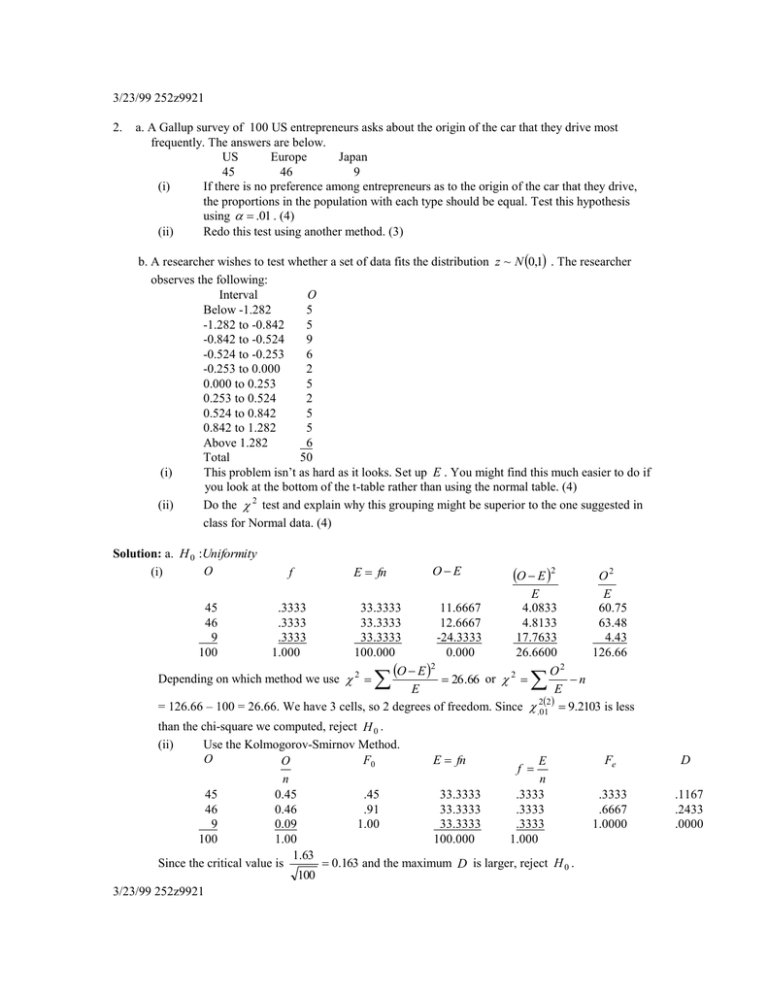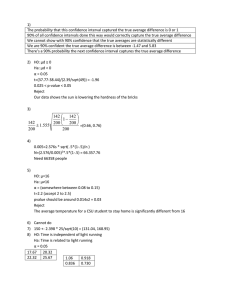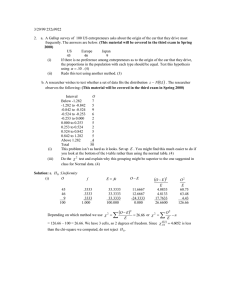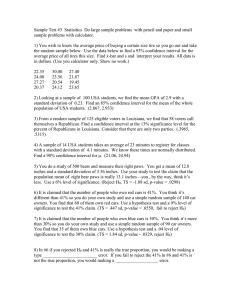Document 15930470
advertisement

3/23/99 252z9921 2. a. A Gallup survey of 100 US entrepreneurs asks about the origin of the car that they drive most frequently. The answers are below. US Europe Japan 45 46 9 (i) If there is no preference among entrepreneurs as to the origin of the car that they drive, the proportions in the population with each type should be equal. Test this hypothesis using .01 . (4) (ii) Redo this test using another method. (3) b. A researcher wishes to test whether a set of data fits the distribution z ~ N 0,1 . The researcher observes the following: Interval O Below -1.282 5 -1.282 to -0.842 5 -0.842 to -0.524 9 -0.524 to -0.253 6 -0.253 to 0.000 2 0.000 to 0.253 5 0.253 to 0.524 2 0.524 to 0.842 5 0.842 to 1.282 5 Above 1.282 6 Total 50 (i) This problem isn’t as hard as it looks. Set up E . You might find this much easier to do if you look at the bottom of the t-table rather than using the normal table. (4) (ii) Do the 2 test and explain why this grouping might be superior to the one suggested in class for Normal data. (4) Solution: a. H 0 :Uniformity O (i) 45 46 9 100 f .3333 .3333 .3333 1.000 OE E fn 33.3333 33.3333 33.3333 100.000 O E 2 11.6667 12.6667 -24.3333 0.000 O E 2 E 4.0833 4.8133 17.7633 26.6600 O2 E 60.75 63.48 4.43 126.66 O2 n E E = 126.66 – 100 = 26.66. We have 3 cells, so 2 degrees of freedom. Since .2012 9.2103 is less Depending on which method we use 2 26 .66 or 2 than the chi-square we computed, reject H 0 . (ii) Use the Kolmogorov-Smirnov Method. O F0 E fn E O f n n 45 0.45 .45 33.3333 .3333 46 0.46 .91 33.3333 .3333 9 0.09 1.00 33.3333 .3333 100 1.00 100.000 1.000 1.63 0.163 and the maximum D is larger, reject H 0 . Since the critical value is 100 3/23/99 252z9921 Fe D .3333 .6667 1.0000 .1167 .2433 .0000 b. (i) H 0 : N 0,1 According to the t-table 1.282 z.10 , 0.842 z .20 , 0.524 z 30 etc. So Pz 1.282 .10 , P1.282 z 0.842 .10 etc. O OE (ii) f E fn O E 2 O2 E E 5 .10 5 0 0.0 5.0 5 .10 5 0 0.0 5.0 9 .10 5 4 3.2 16.2 6 .10 5 1 0.2 7.2 2 .10 5 -3 1.8 0.8 5 .10 5 0 0.0 5.0 2 .10 5 -3 1.8 0.8 5 .10 5 0 0.0 5.0 6 .10 5 0 0.0 5.0 6 .10 5 1 0.2 7.2 50 1.00 50 0 7.2 57.2 We have 10 cells, so 9 degrees of freedom. Since .2019 16.9190 is greater than the chi-square we computed, accept H 0 . This grouping is superior to the one shown in class because if n 50 , there will be no items in the E column that are below 5, a condition that calls for cutting the number of cells. 7 3/23/99 252z9921 3. a. In an ad that appeared in the Sunday Inquirer Parade Magazine (numbers slightly modified), Astra Pharmaceuticals reported that the most frequent adverse reaction to its heartburn drug, Prilosec, was a headache. In the reported test 32 out of 465 getting Prilosec reported a headache, while 5 out of 73 getting a placebo reported a headache as did 15 out of 195 getting Ranitidine, another heartburn medication. Test if there is a significant difference between these three proportions. .05 (6) b. Why can’t the problem above be done by the Kolmogorov-Smirnov method? (1) c. (Extra Credit) I lied. Actually the number that received the placebo was 64 and 4 had an adverse reaction. Why did I have to change the numbers? (2) d. Test the hypothesis that the proportion reporting headaches with Prilosec was lower than with Ranitidine. (4) Solution: a. H 0 : Homogeneous H 1 : Not homogeneous O DF r 1 c 1 1 2 2 2 2 .05 5.9915 pr E sum pr 32 5 15 52 .070941 32 .988 5.179 13 .834 .070941 433 68 180 681 .929059 432 .012 67 .821 181 .166 .929059 sum 465 73 195 733 1.00000 sum 465 .000 73 .000 195 .000 1.00000 The proportions in rows, p r , are used with column totals to get the items in E . Note that row sums in E are the same as in O . O E 32 5 15 433 68 180 733 32.988 5.179 13.834 432.012 67.821 181.166 733.000 O2 E 31.042 4.827 16.265 433.990 68.179 178.841 733.144 OE O E 2 -.98772 -.17872 1.16644 .98772 .17872 -1.16644 0.00000 E .02957 .00617 .09835 .00226 .00047 .00751 .14433 O E 2 O2 n E E 733 .144 733 0.144 Since this is less than 5.9915. do not reject H 0 . b. The Kolmogorov-Smirnov test can only be used when the parameters are known. In tests of independence or homogeneity, the proportions in each row and column are the parameters and are estimated in the process of putting together E . c. The problem is partially set up with the correct values below. O sum pr E pr 32 4 15 51 .07044 32 .756 433 60 180 ? .? ? sum 465 64 195 724 1.00000 sum 465 .000 We get a cell with a value below 5, which can complicate the solution. 4.508 13 .736 .07044 ? ? ? 64 .000 195 .000 1.00000 8 3/23/99 252z9921 d. From Table 3 of the Syllabus Supplement: Interval for Confidence Interval p p z 2 sp Difference between proportions q 1 p p p1 p2 p1q1 p2 q 2 n1 n2 s p Hypotheses Test Ratio H 0 : p p0 H 1 : p p0 p 0 p 01 p 02 or p 0 0 z p p 0 p If p 0 p p01q 01 p02 q 02 n1 n2 Or use s p Critical Value pcv p0 z 2 p If p0 0 p p0 q 0 1 n1 1 n2 n p n2 p2 p0 1 1 n1 n 2 H 0 : p1 p 3 H 0 : p1 p 3 0 32 15 p1 .068817 , p 3 .076923 , or 465 195 H : p p H : p p 0 3 3 1 1 1 1 32 15 .071212 , .05, z 1.645 . p p1 p3 .008106 , p 0 465 195 H 0 : p 0 Same as H 1 : p 0 p p 0 q 0 1 Test Ratio: z n1 1 n3 p p 0 p .071212 .928788 1 465 1195 .02194 .008106 0 0.369 This is above -1.645. .02194 or Critical Value: pcv p0 z p 0 1.645 .02194 .03609 p .008106 is above this value. or Confidence Interval: p p z s p where s p p1 q1 p 3 q 3 . ( I’ll do it if you do it!). The n1 n3 interval includes 0. In all cases do not reject H 0 . 9 3/23/99 252z9921 4. Two fuel additives are being tested to see whether the there is a significant difference in miles per gallon for the two additives. The data is below. difference x1 x2 16.7 21.3 -4.6 17.3 18.7 -1.4 17.5 19.8 -2.3 18.2 22.1 -3.9 18.4 17.8 0.6 18.4 18.2 0.2 18.6 18.7 -0.1 19.1 21.3 -2.2 You may need some of the following numbers: .05, x1 18.025 , s1 0.788 , n1 8, x 2 19.738 , s 2 1.636 , n2 8, and d 1.713, s d 1.905. a. Test for a significant difference in miles per gallon if these are independent samples and the underlying distribution is not Normal. (5) b. Test for a significant difference in miles per gallon if each line represents results for a single vehicle and the underlying distribution is not Normal. (5) c. Test for a significant difference in miles per gallon if each line represents results for a single vehicle and the underlying distribution is Normal. (5) Solution: a. Wilcoxon-Mann-Whitney Method H 0 : 1 2 x1 r1 x2 H 1: 1 2 r2 If we correct the starred items we get the following: 16.7 17.3 17.5 1 2 3 18.2 17.8 4 5* 18.2 6* r1 18.4 7* 18.4 8* 18.6 9 18.7 18.7 10* 11* 19.1 12 19.8 21.3 21.3 22.1 *tie 13 14* 15* 16 r2 1 2 3 5.5 7.5 7.5 9 12 47.5 4 5.5 10.5 10.5 13 14.5 14.5 16 88.5 16 17 Check: 47 .5 88 .5 126 2 For a 5% two-tailed test, Table 6 says that the lower critical value is 49. The lower of the two rank sums, W 47.5 is below this value, so reject H 0 . 10 3/23/99 252z9921 b. Wilcoxon Signed rank test for paired data. H 0 : 1 2 H 1 : 1 2 . difference rank If we add items with + and – signs separately, we -4.6 8find T 31, T 5 . To check this, compute -1.4 4T T 31 5 36 89 . From Table 7 -2.3 62 -3.9 7with n 8 , TL TL .025 4 , and since 5, 0.6 3+ 2 0.2 2+ the smaller T is above the critical value, do not -0.1 1reject H 0 . -2.2 5- c. Test of equality of means for paired data. H 0 : 0 H : 2 or 1 2 or 0 1 H1 : 0 H 1 : 1 2 sd sd n 1.905 8 Test Ratio: t H 0 : 1 2 0 H 1 : 1 2 0 d 1.713, s d 1.905, 3.629025 .1089 0.6735 , DF n 1 7, t .7025 2.365 8 d 0 1.713 0 2.529 sd 0.6735 This is not on the Interval between –2.365 and +2.365. or Critical Value: d cv 0 t s d 0 2.365 0.6735 1.593 2 d 1.713 is not on this interval. or Confidence Interval: d t 2 s d 1.713 1.593 or –3.306 to –0.120. This interval does not include 0. With all methods reject H 0 . Note that this method is more powerful than the one in c. However, it still should not be used unless the conditions justify it. 3/23/99 252z9921 5. The second column from the last page is repeated. (Use .05 ) x2 21.3 18.7 19.8 22.1 17.8 18.2 18.7 21.3 You may need some of the following numbers: x 2 19 .738 , s 2 1.636 , n 2 8 . a. Test these data to see if the distribution is Normal. (5) b. Test these data to see if the distribution is Normal with a mean of 17 and a standard deviation of 0.5. (5) c. Assume that the distribution is not normal and test whether these data have a median of 17.2 (3 – 5 if you use a method learned recently) Solution: a. H 0 : N ?, ? H 1 : Not Normal Because the mean and standard deviation are unknown, this is a Lilliefors problem. The x values must be x x x 19 .738 in order From the data we find that x 19.738 and s 1.636 . t .This is often s 1.636 called z as in a K-S problem and F t is a cumulative Normal probability computed just like F z below. x t F t O O n Fo D 17 .8 19 .8 21 .3 21 .3 22 .1 1.18 0.94 0.63 0.63 0.04 .1190 .1736 .2643 .2643 .5160 1 1 1 1 1 0.95 .8289 1 0.95 .8289 1 1.44 .9251 1 0.125 0.125 .0060 18 .2 0.125 0.250 .0764 18 .7 0.125 0.375 .1107 18 .7 0.125 0.500 .2357 0.125 0.125 0.625 0.750 .1090 .0789 O n 8 0.125 0.125 0.825 1.000 .0461 .0749 MaxD .2357 Since the Critical Value for .05 is .285 , do not re ject H 0 . b. H 0 : N 17 ,0.5 H 1 : Not N 17 ,0.5 Because the mean and standard deviation are known, this is a Kolmogorov-Smirnov problem. x x 17 The x values must be in order z . 0 .5 x 17 .8 18 .2 18 .7 18 .7 19 .8 21 .3 21 .3 22 .1 z F z O O n Fo D 1.60 .9452 1 2.40 .9918 1 3.40 .9997 1 3.40 .9997 1 5.60 1.000 1 8.60 1.000 1 8.60 1.000 1 10 .20 1.000 1 O n 8 0.125 0.125 0.125 0.125 0.125 0.125 0.125 0.125 0.125 0.250 0.375 0.500 0.625 0.750 0.825 1.000 .8202 .7418 .6247 .4997 .3750 .2500 .1250 .0000 Note that it might be better to group the repeated values together with O 2 and MaxD .8202 Since the Critical Value for .05 is .454 , reject H 0 . O .25 . It would not n affect the results. 12 3/23/99 252z9921 c. Wilcoxon Signed rank test for paired data. H 0 : 7.2 H 1 : 7.2 The x values need not be in order (but it makes things easier). ‘difference’ below is x . .05 x difference rank So T 0, T 36 . To check this, compute 17.8 0.6 1+ 18.2 1.0 2+ T T 0 36 36 89 . From Table 7 18.7 1.5 3.5+ 2 18.7 1.5 3.5+ with n 8 , TL TL .025 4 , and since 5, 2 19.8 2.6 5+ 21.3 4.1 6.5+ the smaller T is below the critical value, reject 21.3 4.1 6.5+ H0. 22.1 4.9 8 An alternative and less powerful test is the sign test. Here, note that there are 8 numbers above the median. pvalue 2Pz 8 21 Pz 8 21 .99609 2.00391 .00782 . Since this is below the significance level, reject H 0 . 13 3/24/99 252z9921 6. In a wage discrimination case the following hourly wage data is reported. .05 A Normal distribution is assumed. Men Women n1 31 n 2 17 x1 9.25 a. b. c. d. x 2 8.70 s1 0.90 s 2 1.30 Test the statement that the variance for women is greater than the variance for men. (2) Test the statement that the variance for women is not equal to the variance for men. (2) Test the hypothesis that men have a wage less than or equal to that of women, assuming that the variances differ between the two populations. (6) Repeat the test in c using the same sample means and variances, but assuming that n1 310 and n 2 170 . (4) H 0 : 12 22 s 2 1.30 2 16,30 1.99 Solution: a. is smaller than .05 , 22 2.08 . Since F F.05 2 s1 H 1 : 12 22 0.90 2 our ratio, reject H 0 . H 0 : 12 22 b. H 1 : 12 22 check is s 22 s12 s12 s 22 0.90 2 1.30 2 1, s 22 s12 2.08 . Since the first ratio is below 1, the only one we need 16,30 2.28 . Since F F.025 is larger than our ratio, do not reject H 0 . 2 H 0 : 0 H 0 : 1 2 H 0 : 1 2 0 c. or , .05 . See problem II for where 1 2 or H 1 : 0 H 1 : 1 2 H 1 : 1 2 0 formulas. n1 31, x1 9.25, s1 0.90 , n 2 17, x 2 8.70, s 2 1.30 , d x1 x 2 0.55 . s12 0.90 2 0.02613 n1 31 s 22 1.30 2 0.09941 n2 17 s12 s 22 0.12554 n1 n 2 DF s12 s 22 n1 n 2 2 sd s12 s 22 0.12554 0.3543 n1 n 2 2 2 s12 s 22 n1 n2 n1 1 n2 1 0.12554 2 0.02613 2 0.09941 2 30 24 .609 , so use 24 degrees of freedom. 16 14 3/23/99 252z9921 t .24 05 1.711. Test Ratio: t d 0 0.55 0 1.552 This is below 1.711. sd 0.3543 or Critical Value: d cv 0 t 2 s d 0 1.7110.3543 0.607 . 0.55 lies below this value. or Confidence Interval: d t s d 0.55 1.711 0.3543 0.057 This interval includes 0. In all cases do not reject H 0 . d. H 0 : 0 H : 2 H 0 : 1 2 0 or 0 1 , where 1 2 or H 1 : 0 H 1 : 1 2 H 1 : 1 2 0 n1 310 , x1 9.25, s1 0.90 , n 2 170 , x 2 8.70, s 2 1.30 , d x1 x 2 0.55 . Because of the large sample size, we can act as if the variances were known. From Table 3 in the syllabus supplement: Interval for Confidence Hypotheses Test Ratio Critical Value Interval Difference Between Two Means ( known) H 0: 0 d z 2 d d 12 n1 22 n2 t H1 : 0 1 2 d 0 sd d cv 0 z 2 d d x1 x 2 z .05 1.645 , sd Test Ratio: z s12 s 22 n1 n 2 0.90 2 1.30 2 310 170 0.1120 d 0 0.55 0 4.991 This is above 1.645. sd 0.1120 or Critical Value: d cv 0 t 2 s d 0 1.645 0.1120 0.1842 . 0.55 lies above this value. or Confidence Interval: d t s d 0.55 1.645 0.1120 0.366 This interval does not include 0. In all cases reject H 0 . 15 3/24/99 252z9921 IV. Computer Problem. 1. Hand in your first problem (3 – 2point penalty for not handing in). 2. Assume that your output is: MTB > ttest mu = 30 ‘glop’; SUBC > alt =1. TEST OF MU=30 VS MU > 30 Variable N Mean StDev glop 20 36.00 9.23 SE Mean T P-Value 2.06 2.91 0.0045 (Don’t do this problem unless you handed in the computer problem.) Show how the value of t was computed from the values of the mean and standard deviation (1) b. Give the null hypothesis and tell, using the p-value, whether (and why) you would accept it if .075 . (1) c. What would the p-value be for the following tests (2): (i) MTB > ttest mu = 30 ‘glop’ (ii) MTB > ttest mu = 30 ‘glop’; SUBC > alt = -1. x 0 36 .00 30 s 9.23 2.92, s x 2.06 . Solution: a. t sx 2.06 n 20 a. The rule on p-value: if the p-value is less than the significance level reject the null hypothesis; if the p-value is greater or equal than the significance level, do not reject the null hypothesis. H : 30 b. 0 Since .0045 is less than the significance level ( .075 ), H 1 : 30 reject H 0 . c. See diagrams. (i) Since this is a 2-sided test, double the probability between t and the nearest corner. Thus the p-value is 2(.0045) = .009. (If .075 , reject H 0 .) (ii) This is the opposite test, so the p-value is 1 - .0045 = .9955. (If .075 , do not reject H 0 .) 16




